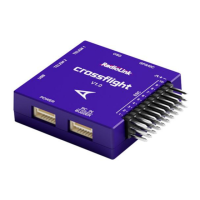Radiolink Electronic Ltd
www.radiolink.com
(2) The vehicle travels outside of RC range.
(3) The receiver loses power (unlikely).
(4) The wires connecting the receiver to the flight controller are broken (unlikely).
When a radio Failsafe is triggered one of the following will happen:
(1) Nothing if the vehicle is already disarmed.
(2) Motors will be immediately disarmed if the vehicle is landed OR in stabilize or acro mode and the pilot’s
throttle is at zero.
(3) Return-to-Launch (RTL) if the vehicle has a GPS lock and is more than 2 meters from the home position.
(4) LAND if the vehicle has:
no GPS lock OR
is within 2 meters of home OR
the FS_THR_ENABLE parameter is set to “Enabled Always Land”
If the Failsafe clears (i.e. transmitter and receiver regain contact) the copter will remain in its current flight
mode. It will not automatically return to the flight mode that was active before the Failsafe was triggered.
This means that if, for example, the vehicle was in Loiter when the Failsafe occurred and the flight mode was
automatically changed to RTL, even after the transmitter and receiver regained contact, the vehicle would
remain in RTL. If the pilot wished to re-take control in Loiter he/she would need to change your flight mode
switch to another position and then back to Loiter.
Copter also supports Battery, Ground Station and EKF/DCM failsafes.
You can check your Failsafe by performing the following tests with the CrossFlight connected to the Mission
Planner either via a USB cable or telemetry link. You can complete these tests without plugging in your LiPo
battery but if you do connect a battery you should first remove the propellers.
Test #1: if using the “Low-Throttle” method, ensure the throttle channel drops with loss of radio contact
Ensure your RC transmitter is on and connected with the throttle all the way down and flight mode set to
Stabilize
The throttle (channel 3) PWM value should be approximately as in first illustration below. Its value may be
higher or lower but it should definitely be at least 10 higher than the value held in the FS PWM field
Turn the transmitter off and the throttle PWM value should drop to be at least 10 below the FS PWM field
value (as in the second illustration below) below
Test #2: ensuring motors disarm if in stabilize or acro with throttle at zero
Switch to stabilize mode, arm your motors but keep your throttle at zero. Turn off your transmitter. The
motors should disarm immediately (red led will start flashing, DISARMED will be displayed in the Mission
Planner’s Flight Data screen).
Test #3: ensuring flight mode changes to RTL or LAND when throttle is above zero
Switch to stabilize mode, arm your motors and raise your throttle to the midpoint. Turn off your transmitter.
The Flight Mode should switch to RTL if you have a GPS lock or LAND if you do not have a GPS lock (the
flight mode and GPS lock status are visible in the Mission Planner’s flight data screen).
Test #4: retaking control after the failsafe has cleared
continuing on from test #3, turn your transmitter back on
while the flight mode is still in RTL or LAND and armed, change the flight mode switch to another position
and then back to stabilize mode. Ensure that the flight mode displayed on the Failsafe page is updating
appropriately.

